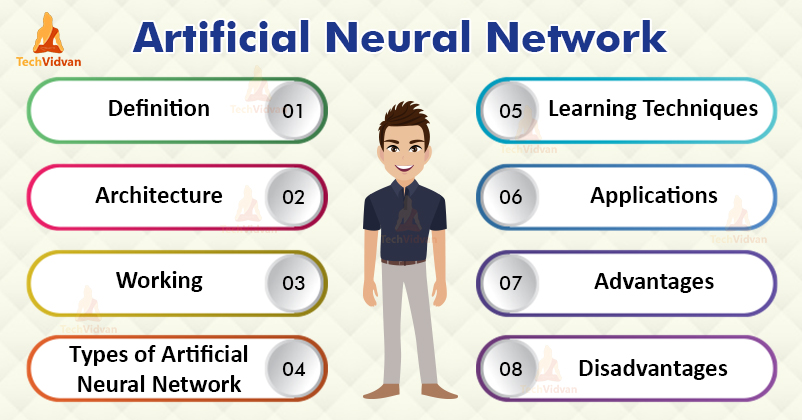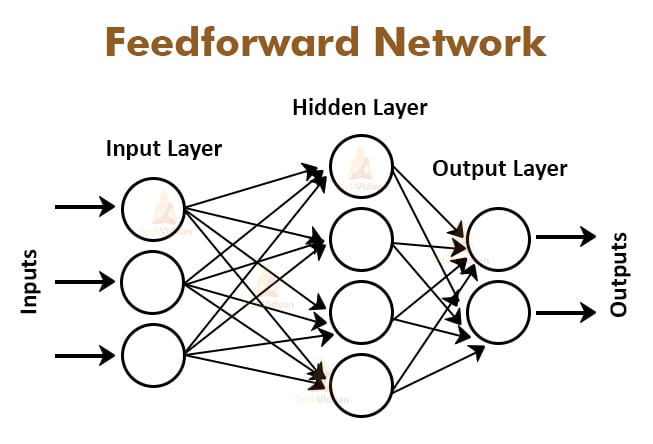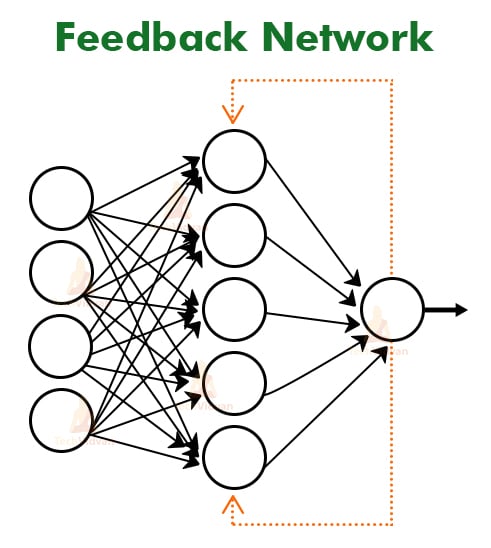Artificial Neural Network – Applications, Algorithms and Examples
Artificial neural network simulate the functions of the neural network of the human brain in a simplified manner. In this TechVidvan Deep learning tutorial, you will get to know about the artificial neural network’s definition, architecture, working, types, learning techniques, applications, advantages, and disadvantages.
Artificial Neural Network Definition
An artificial neural network (ANN) is a computational model to perform tasks like prediction, classification, decision making, etc. It consists of artificial neurons. These artificial neurons are a copy of human brain neurons. Neurons in the brain pass the signals to perform the actions. Similarly, artificial neurons connect in a neural network to perform tasks. The connection between the artificial neurons is called weight.
Artificial Neural Network Architecture
A neural network consists of three layers. The first layer is the input layer. It contains the input neurons that send information to the hidden layer. The hidden layer performs the computations on input data and transfers the output to the output layer. It includes weight, activation function, cost function.
The connection between neurons is called weight, which is the numerical values. The weight between neurons determines the learning ability of the neural network. During the learning of artificial neural networks, weight between the neuron changes. Initial weights are set randomly.
To standardize the output from the neuron, the “activation function” is used. Activation functions are the mathematical equations that calculate the output of the neural network. Standardization refers to the transformation of data to have mean 0 and standard deviation 1. Each neuron has its activation function. It is difficult to understand without mathematical reasoning. It also helps to normalize the output in a range between 0 to 1 or -1 to 1. An activation function is also known as the transfer function.
ANN Working
The input node takes the information in numerical form. The information represents an activation value where each node has given a number. The higher the number, the greater the activation. Based on weights and activation function, the activation value passes to the next node. Each node calculates the weighted sum and updates that sum based on the transfer function(activation function). After that, it applies an activation function. This function applies to this particular neuron. From that, the neuron concludes if it needs to forward the signal or not. ANN decides the signal extension on the adjustments of the weights.
The activation runs through the network until it reaches the output node. The output layer shares the information in an understanding way. The network uses the cost function to compare the output and expected output. Cost function refers to the difference between the actual value and the predicted value. Lower the cost function, closer it is to the desired output.
There are two processes for minimizing the cost function.
1) Back Propagation
Back propagation is the core of neural network training. It is the prime mechanism by which neural networks learn. Data enters the input layer and propagates in the network to give the output. After that, the cost function will equate the output and desired output. If the value of the cost function is high then the information goes back, and the neural network starts learning to reduce the cost function by adjusting the weights. Proper adjustment of weights lowers the error rate and makes the model definitive.
2) Forward Propagation
The information enters into the input layer and forwards in the network to get the output value. The user compares the value to the expected results. The next step is calculating errors and propagating the information backward. This permits the user to train the neural network and modernize the weights. Due to the structured algorithm, the user can adjust weights simultaneously. It will help the user to see which weight of the neural network is responsible for error.
Types of Artificial Neural Network
1) Feedforward Network
This network contains an input, hidden, and output layer. Signals can move in only one direction. Input data passes to the hidden layer to perform the mathematical calculations. Processing element computes according to the weighted sum of its inputs. The output of the previous layer becomes the input of the following layer. This continues through all the layers and determines the output.
Eg: Data mining
2) Feedback network
This network has feedback paths. It means signals can travel in both the direction using loops. Neurons can have all the possible connections. Due to loops, it becomes a dynamic system that changes continuously to reach in the equilibrium state.
Eg: Recurrent neural network
ANN Learning Techniques
1) Supervised Learning
In this learning, the user trains the model using labelled data. It means some data is already marked with the correct answers. Supervised learning can be compared to the learning which is held in the presence of a supervisor.
2) Unsupervised learning
In this learning ,the model does not need supervision. It usually deals with the unlabelled data. User permits the model to work on its own to classify the data. It sorts the data according to the similarities and patterns without any prior training to the data.
Artificial Neural Network Applications
1) Text classification and categorization
It is an essential part of many applications like web searching, information filtering, and language identification.
2) Medical
We can use it in detecting cancer cells and analyzing the MRI images to give detailed results.
3) Paraphrase detection
Question answering system needs to determine whether two sentences have the same meaning or not. Artificial neural networks are very helpful in paraphrasing detection.
4) Forecast
We can use it in every field of business decisions like in finance and the stock market, in economic and monetary policy.
5) Image processing
We can use satellite imagery processing for agricultural and defense use.
ANN Advantages
1) It has a parallel processing ability. It has the numerical strength that performs more than one task at the same time.
2) Failure of one element of the network does not affect the working of the whole system. This characteristic makes it fault-tolerant.
3) A neural network learns from the experience and does not need reprogramming.
Disadvantages of ANN
1) Its black-box nature is the most prominent disadvantage of ANN. The neural network does not give the proper explanation of determining the output. It reduces trust in the network.
2) The duration of the development of the network is unknown.
3) There is no assurance of proper network structure. There is no proper rule to determine the structure.
Conclusion
Artificial neural networks are powerful models to solve the problems. Mostly, neural network methods exceed other methods. Hope you understood the architecture, working , types, applications, advantages, and disadvantages of the artificial neural network.




